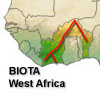 



Weather data
A large number of automatic weather stations has been implemented in the frame of the BIOTA AFRICA project by the Namibian National Botanical Research Institute (NBRI) and the Group "Biodiversity, Evolution and Ecology" (BEE) of the University of Hamburg. The website offers hourly updates of data and graphs of a large number of weather parameters.

|
 BIOTA West Africa - Workpackage - CT2-T3-WP1
BIOTA West Africa - Workpackage - CT2-T3-WP1
Core Topic (CT) |
Land use changes: agriculture and restoration |
Topic (T) |
Restoration of degraded systems |
Title |
 Restoration of degraded systems by replanting highly valued local woody species
Restoration of degraded systems by replanting highly valued local woody species
|
Project leader(s) |
Dr. Karen Hahn-Hadjali & Prof. Dr. Rüdiger Wittig
Prof. Dr. K. Eduard Linsenmair
Prof. Dr. Adjima Thiombiano
|
Project description |
The urgency for restoration of degraded ecosystems has been widely recognised for many years in Africa and various techniques were developed and are applied. One of these is the enhancement of natural succession by introducing mostly exotic species, whereas the inclusion of indigenous tree species is so far rarely considered, despite the fact, that many of the naturally occurring species are – for their multipurpose use – highly valued by local people. To develop better strategies and approaches, well adopted by local people, experiments with local species were started during the BIOTA project, showing very promising results.
To follow up our long term objective, the following issues are addressed:
- Identification and testing of appropriate species for restoration in the Subsahelian/Sudanian zone, based on ecological knowledge on the pioneer qualities of species as well as interviews on the use value of species for local communities.
- Different planting experiments (with and without Zaï) and monitoring of restoration success in both vegetation zones for developing the best low-budget methods. In addition, this base-line data will serve for evaluating the success of the deep ploughing technique in comparison to the Zaï system and for gaining more information on ways of successfully breeding local woody species in tree nurseries.
- Compiling a manual on best practices for dissemination and integrating the results and data into existing Internet data bases on restoration practices (in collaboration with BIOTA Southern Africa).
|
|
|






 Go to the WeatherNet
Go to the WeatherNet BIOTA West Africa - Workpackage - CT2-T3-WP1
BIOTA West Africa - Workpackage - CT2-T3-WP1 Restoration of degraded systems by replanting highly valued local woody species
Restoration of degraded systems by replanting highly valued local woody species